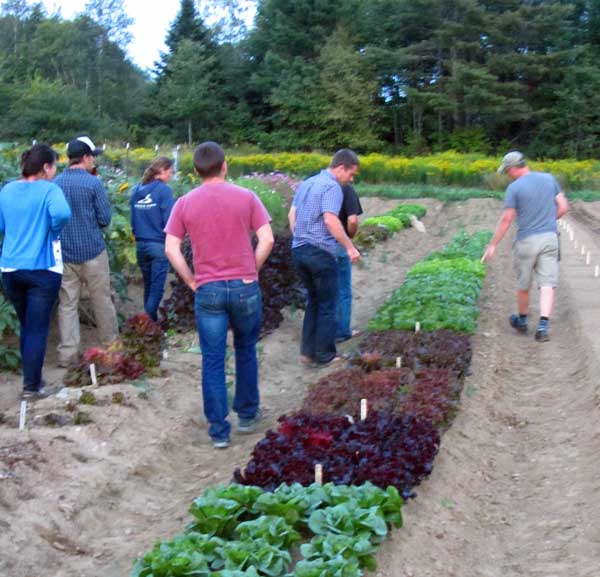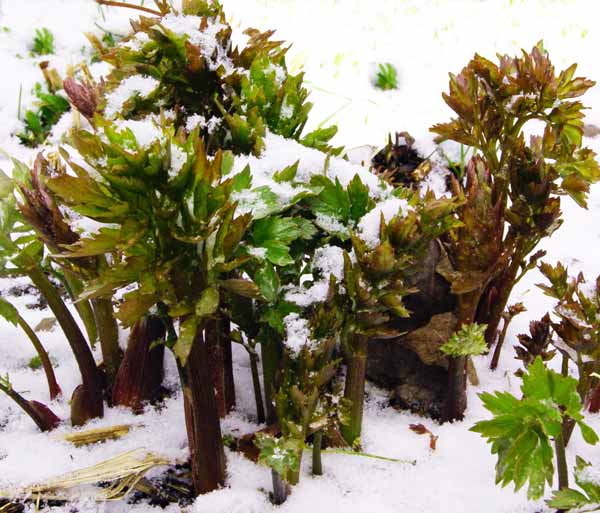

When I was managing our market garden, I made it a point to continually trial new varieties. This was a process of seeing if it grew well with our soil, cultural practices, climate, and endemic pests. Many trials would fail on at least one of these important criteria. If the variety was similar to something we were already successfully growing, it would also need to have enhanced flavour, better keeping qualities, improved appearance, and/or higher yields.
The next step was to determine if it matured evenly, was easy to harvest, could be easily cleaned, and would keep well enough to survive a trip to market. [Some of the wonderful heirloom lettuces and tomatoes would fair well on all counts except they withered a few hours after harvest. They had been selected during the days of kitchen gardens when they only needed to survive a few steps to the kitchen and a few minutes to the table.]
And then there is the all-important aspect of marketing the new variety. A quick calculation of production costs could indicate a fair selling price. (I quickly approximated this price by counting how much could be harvested in one-hour then multiplying this $50 and dividing by the harvested units.) And then I would taste and use this new variety to predict ways it might provide value to my chefs and customers.
If my portrayal of its value was accepted, we would continue producing the new variety. Support by chefs and customers was an integral part of the process. The $50 multiplier usually generated a price somewhat lower than the actual full Costs of Production. But this was not a concern because sales of new varieties were typically low. By the time sales became significant, we had developed production efficiencies.
Back in the days when it required expensive international phone calls (often speaking directly with breeders), awkward faxes, and mailed money orders to obtain interesting seeds, it was exciting to obtain new (to Ontario) varieties. But this was just the start. Then we had to produce our own seeds; or coax a seed grower to do this for us. Nowadays it is so quick and easy to find and purchase new varieties, that everyone is doing it. But the cost for this convenience has been a reduction in the choices for varieties with unique characteristics of interest to chefs and home cooks has been dwindling.
Multi-national seed companies have purchased most of the world’s smaller vegetable seed companies. They have “rationalized” the product lists (reduced the choices), and added “Patented (PVP)” seeds (which may not be legally saved). But now, as with the IT industry, you can choose a wide assortment of “open source” varieties. Many of the world’s most creative variety developers have joined together to create the Open Source Seed Initiative (OSSI).

Oca is another of the inspired root vegetables developed by the Inca. (Others already introduced to the world are potato and sweet potato.)
Popping Beans (a version of chickpea) is a more nutritious alternative to popcorn. Few growers realize these can succeed in cool climates. If they can be grown in Thunder Bay (which they can), they can be grown just about anywhere.
Huazontle is a favourite Mexican leafy green. Being a slow bolting cultivated selection of a common (and delicious) garden weed – Lambs Quarters – this is certainly worth trying.
Lingon Berries are common and popular in Sweden. Wild harvested in Canada they are known as lowbush cranberries, partridgeberries, bearberries, and graines rouges. They are a sweeter and brighter red dry-land alternative to cranberries.
Lovage is the perennial cousin of celery with an absolutely enchanting aroma. It is the first garden crop ready for harvest in the spring. Why struggle growing celery when nothing is more reliable and delectable than lovage.
Globe Artichoke is a darling of the vegetable world. It is harvested in California during the winter months; but new varieties can be harvested in cooler climes during the summer months.
Burdock burs give this plant a bad rap. But it is genetically (and flavourly) nearly the same plant as a Globe Artichoke. The root can be successfully stored and enjoyed all winter.
Royal Gold Potato was developed by the same University of Guelph team that brought us Yukon Gold. I grew them for Toronto chefs who loved this beautiful and delicious (but difficult to store) gem. Robert Marcott has continued to grow them for adoring Montreal chefs, but they too have been falling in love with cheap foods. Robert will share seed stock with whomever is willing to maintain these wonderful genetics.

As our ponds, lakes, rivers and pools warm, they not only provide a source of entertainment, they also supply irrigation water. It was not like this during the Middle East’s 2006 to 2010 draught that contributed the disruptions which continue in Syria, Iraq, and Iran to this day. Neither is it like what is becoming a mega-draught afflicting California. NASA studies are now predicting that a 20-year (which is NASA-code for perpetual) draught is becoming more and more likely. Water is a coveted resource.
For a fun way to understand how much water is intrinsically required to put food on your plate, this interactive game from the Los Angeles Times is most informative.
Due to our strong dependence on California imports, current projections are for a 20% increase in Canadian produce prices over the next few years. Much of this will be due to California brokers no longer having a need to dump their excess produce into Canada. Since Canada produces less than 25% of the organic food currently being purchased and 80% of the organic imports are currently coming from California, this segment will be affected even more. On the other hand, this presents tremendous opportunity for Ontario farmers.
By far the two main crops coming from California are lettuces and strawberries. Since these grow during the winter months, greenhouses are an obvious solution. The perception is that operating these structures is expensive. But this technology has made tremendous advances in efficiency. With state-of-the-art greenhouses, I have Organic clients keeping their combined heating (at a productive 10°C) and greenhouse depreciation and interest costs below 10% of sales. The advantages of year-round production for both customers and employees certainly outweigh its cost.
Some Midwestern states are already foreseeing the demise of California (and Chinese) produce production. If Ontario investors, lenders, planners, educators, governments, distributors and consumers do not start proactively supporting local foods, we may find that Michigan and Ohio assume the California mantle.
We do not appear to have any forthcoming shortage of water. But we are rapidly losing good farmland. So preserving what we still have is a worthy cause. This is a mandate of Ontario Farmland Trust Alliance. You can support their May 14th fundraising event: Save the Land You Love with noted photographer Neil Ever Osborne. Learn more about protected areas in North and South America.
The Organic Council of Ontario (OCO) has prepared three thorough Brochures to assist conventional growers Transition to Organic. Each of these describes the outstanding market potentials and explains why expenses are lower and prices are higher. These Brochures about Transitioning to Beef, Grains, or Vegetables also list numerous resources to facilitate transitions. Please download or print each of these PDF documents to share with any curious farmers you know.
Glenn Murray, the Ontario Minister of the Environment and Climate Change, gave a thoughtful and informative keynote address at the recent Organic Council of Ontario Awards Dinner. My biggest takeaway was learning how he convinces belligerent farmers to understand the bigger picture of removing Neonicotinoids from their arsenal. He has found that doing this around kitchen tables is more effective than with tweets and emails. You can do the same:
The story about reducing insecticide dust is not the whole story. The chemical is absorbed into the plant to release its neuro-poison to insects that suck or chew on the plant. As these fly away, insect-eating birds also become neuro-poisoned. For some plants the poison may be transferred into the pollen, which then weakens the bee colonies (that farmers rely on for pollination).
Then the story gets even worse. Most of this water-soluble chemical does not even make it into the target plants. It moves through the soil to get into the weeds to provide them with insect protection. [Think of milkweed and Monarch butterflies.] Or it flows into creeks or the water table where it eventually plays havoc on salamanders and frogs. All this would be tolerable in small quantities. But the chemical remains active and accumulating and recirculating through the environment for many years.
Since the seed companies are owned by the chemical companies they provide the treated seeds for no extra charge. It has become so difficult to avoid, that 99% of Ontario conventional corn is treated and 95% of commercial dried beans are treated. 65% of soybeans are prophylactically treated (but it is generally accepted this provides no economic benefit). And this insecticide is routinely added to commercial vegetable seed treatments, but growers and garden nurseries may not even be aware this has been done for them.
After hearing the rest of the story, the farmers around the kitchen table understand and reluctantly support the forthcoming partial ban on this powerful chemical.
| forward to a friend and suggest signing up to receive this newsletter every month. |